13.1: Introduction to Informative Speaking
13.1.1: Defining an Informative Speech
An informative speech is one that one that intends to educate the audience on a particular topic.
Learning Objective
Define an informative speech
Key Points
- This type of speech uses descriptions, demonstrations, vivid detail, and definitions to explain a subject, person, or place the audience wants to understand.
- An informative speech makes a complex topic easy to understand or offers a different point of view.
- Unlike persuasive speeches, an informative speech relies less on pathos and more on communicating information.
Key Terms
- definition
-
A statement expressing the essential nature of something; formulation.
- informative
-
Providing knowledge, especially useful or interesting information.
An informative speech is one that intends to educate the audience on a particular topic. There are many different types of informative speeches, including speeches that describe the conditions of a subject and speeches that instruct the audience on how to perform an action.
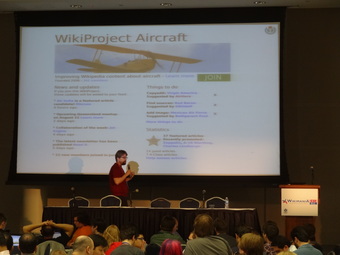
Purpose of the Speech
An informative speech is one that aims to inform the audience about a given topic.
The main goal of an informative speech is to provide enlightenment regarding a specific topic the audience knows nothing about. It may demonstrate how to use a new type of software, explain a new concept in the field of science, describe an expedition an archaeologist took, or provide details about a person of interest that the audience wants to learn more about.
The topics covered in an informative speech should help the audience to understand a subject better and to remember what they learned later. The goal of this type of speech isn’t to sway the audience to the speaker’s point of view. Instead, the details need to be laid before the audience so that they can make an educated decision or learn about a subject they are interested in.

Transferring Information
In an informative speech, how the information is presented will determine how the audience receives it.
However, it is important for the speaker to think about how this information will be presented. An informative speech should rely less on pathos, which is an appeal to the emotions of the audience and an important component of persuasive speeches. Instead, an informative speech might rely on visual aids, for example, in order to give the audience a visual representation of important information contained in the speech. Providing the information in multiple forms during the speech increases the likelihood that the audience will retain the information included in the speech.
13.1.2: Types of Informative Speeches
The four types of informative speeches are definition, explanatory, descriptive, and demonstrative.
Learning Objective
List the four types of informative speeches and describe their use
Key Points
- A descriptive speech helps the speaker create an accurate mental picture in the mind of the audience regarding a specific person, place, or thing.
- A demonstrative speech describes how to perform an action.
- An explanatory speech explains the state of a topic.
- A definition speech explains a concept or theory regarding a topic.
Key Terms
- description
-
A sketch or account of anything in words; a portraiture or representation in language; an enumeration of the essential qualities of a thing or species.
- definition
-
A statement expressing the essential nature of something; formulation.
An informative speech is one that informs the audience. However, as should be clear, this general definition demonstrates that there are many ways to inform an audience. Therefore, there are several types of informative speeches. The main types of informative speeches include definition, descriptive, explanatory, and demonstrative.
A definition speech explains the meaning, theory, or philosophy of a specific topic that the audience likely does not know much about. The topics may be general, such as a sport, or highly specific, like a particular person. The main goal of this speech is to educate the audience so that they understand the main points regarding this subject.
A demonstration speech explains how to do something. If you have ever sat through a lecture where a teacher explained how to create a bibliography, then you have heard a demonstration speech. Like most informative speeches, a how-to speech will likely use visual examples that show the audience how to move from step to step through a particular activity. Visualizations help the audience retain what each step looks like, increasing the likelihood that they will retain the overall information of the speech.

Demonstrative Speech
A demonstrative speech creates a mental image in audience members’ minds.
An explanatory speech might give a description of the state of a given topic. As an example, consider the types of speeches that are given at industry conferences. The goal of these speeches is for the speaker to inform the audience on a particular part of an industry. Commonly, these will also utilize visualizations that give the audience a visual representation of the particular data or statistics contained in the speech. This is one way to condense highly complex information into an easily retainable package for the audience.
A descriptive speech creates a vivid picture in a person’s mind regarding an object, person, animal, or place. An archaeologist who has discovered a new temple in South America or a paleontologist who believes they have found a new dinosaur may use a descriptive speech to inform an interested audience about their recent discoveries .
As all of these types make clear, there are many ways that a given set of information can be communicated in a speech. When deciding what type of informative speech you want to write and deliver, consider what you want the audience to know about your topic.
13.1.3: Subjects of Informative Speeches
Informative speeches can cover many subjects as long as they can be discussed without persuading or altering the perceptions of the audience.
Learning Objective
Name some examples of subjects of an informative speech
Key Points
- When choosing a subject of an informative speech consider whether you want to describe, explain, demonstrate or educate the audience about the topic.
- The subject of an informative speech should be one that can be communicated clearly to an audience.
- When choosing a subject for an informative speech, consider what is the essential information that an audience should know about that subject.
Key Term
- subject
-
A particular area of study.
There are many different subjects that can be used in informative speeches. College lectures about an event in history or a historical figure would be considered informative speeches

Lecture
A lecture is one type of informative speech. It’s usually about an important event or figure in history.
Other examples of subjects for an informative speech include an actor or actress, the field of advertising, a classic film the history of Dracula, social networking websites, and what causes volcanoes.
Each of these examples lends itself to multiple types of information. For example, an informative speech about a particular actor or actress would likely focus on providing a description of who the person is and what movies or plays they have been in. Incorporating famous pictures or clips from works is a way of increasing the audience’s retention of the information about the particular person.
An informative speech about the causes of a volcano could be considered a how-it-happens speech, which could be similar to a how-to speech. A speech about volcanoes might include a model volcano, describing how the model’s functioning is similar to processes in the real world.
More technical subjects, such as the field of advertising, require more technical information and specific data relevant to the industry. Technical subjects especially, but really all informative speeches, benefit from the use of visualizations, such as bar graphs or images. The choice of visual aids depends on what information the speaker wants to inform the audience of. For example, a speech that intends to explore the financial trends of political advertising over ten years would benefit from a bar graph. However, a speech that is informing the audience on how political advertisements have functionally changed over time would benefit from actual examples of ad campaigns.
In order to differentiate an informative speech from other types of speeches, it is important to stick to the basic facts of the subject. No personal biases, unsubstantiated information, or popular opinion should be included when stating the main ideas of the topic. The goal is to educate the audience on the facts, not to provide the speaker’s opinion. When crafting an informative speech look at the subject carefully and eliminate any potential statements that have prejudice or might persuade the audience.
13.2: Effective Informative Speaking
13.2.1: The Goals of an Informative Speech
An effective informative speech should be driven by a series of goals.
Learning Objective
List the goals of an informative speech
Key Points
- One of the goals of an informative speech is to enhance the understanding of the audience.
- Another goal of an informative speech is to maintain the interest of the audience.
- A final goal of an informative speech is for the audience to remember the speech.
Key Terms
- goal
-
A result that one is attempting to achieve.
- inform
-
To communicate knowledge to others.
An effective informative speech requires the speaker to aim for a series of goals. And similar to a soccer match, hitting these goals increases the likelihood of a successful speech. The main goals for an informative speech are to help explain a specific subject and to help the audience remember the knowledge later.
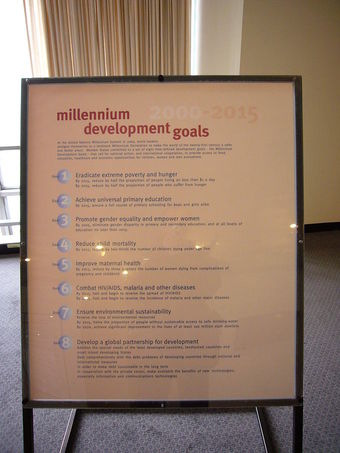
Setting Goals
You need to determine a series of goals in order to create a successful informative speech.
One of the goals, perhaps the most essential goal that drives all informative speeches, is for the speaker to inform the audience about a particular topic. In order to aim for this specific goal, a speaker should consider how best to package the complex understanding that they have cultivated of the topic, from personal experience and research, into an easily communicable form for the audience.
A final, significant goal an effective informative speech is to make the audience remember. Most memorable speeches have emotional appeals that audiences continue to talk about long after the speech is delivered, and sometimes even after the life of the speaker. To make sure that the information contained in a speech is remembered by the audience, the deliverer of an informative speech should combine organization, repetition and focused visualizations to increase the effectiveness of the speech and the likelihood that the audience will leave informed.
One way to help an audience remember the details of an informative speech is to maintain the interest of the audience. The challenge of an informative speech is delivering information in a neutral way that does not bore the audience. Unlike persuasive speeches, which rely heavily on emotional appeal, informative speeches have to demonstrate why the audience should care about the information contained in the speech without compromising a neutral tone.
13.2.2: Scoping Your Speech
Make sure that only the most relevant information is including in the speech, so the scope of your speech does not become too wide.
Learning Objective
Explain how to effectively scope an informative speech
Key Points
- Every piece of information in a speech should relate to the speech topic, purpose, and thesis simultaneously.
- Audiences have a hard time following or understanding speeches that are too broad in scope (that is, speeches that include too much irrelevant or tangential information).
- By keeping all of the information relevant as he or she develops your speech, the speaker’s job becomes easier by keeping all supporting information on point.
Key Term
- scope
-
The extent of the area or subject matter that something deals with or to which it is relevant.
Some speeches contain such a wide range of information that the audience is left wondering what the speaker was trying to communicate. A speech with a scope that is too broad complicates the audience’s ability to retain information. Properly scoping your speech allows the speaker to narrow down what the speech will cover, thus increasing its ability to inform the audience.
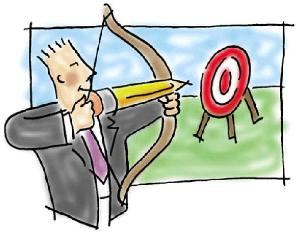
Scope Out a Specific Target
Every piece of information in a speech should be relevant to the topic, purpose and thesis. If it’s only a tangent, it doesn’t belong in the speech.
Scope refers to the extent of the area or subject matter that something deals with or to which it is relevant. The key word here is relevance; the speech should not go in so many different directions that none of those directions relate to the original purpose and thesis of the speech.
One way to effectively scope a speech is to think of the question: “What information do I want my audience to know at the end of the speech? ” Use the answer to this question as a focal point for everything else to be included in your speech. Everything included then must be relevant to your purpose and thesis. Anything superfluous or extraneous is only going to broaden the scope and take the speech away from that ultimate goal.
The evidence and supporting arguments should not only be related tangentially; there should be direct lines of relevance to every piece of information included in your speech.
Scoping a speech is not only helpful for the audience, but is also to the benefit of the speaker. Keeping the speech on point and focused makes it easier for the speaker to build more credible, reinforced arguments. By narrowing the scope of the speech, the speaker improve the speech’s ability to effectively communicate essential information to the audience.
13.2.3: Tailor Complexity to Your Audience
An important component of effective informative speaking is knowing how to tailor the complexity of the speech to the audience.
Learning Objective
Apply knowledge of your audience when composing your speech
Key Points
- Consider the audience that will be hearing your speech.
- Tailoring the complexity of the speech to your audience means considering how best they receive information.
- Considering how much information your audience already knows should help you tailor the complexity of your speech.
Key Term
- complexity
-
The state of being complex; intricacy; entanglement.
Overview
The main goals for an informative speech are to help explain a specific subject and to help the audience remember the knowledge later. To achieve these goals, a speaker should consider how best to package the complex understanding that they have cultivated of the topic, from personal experience and research, into an easily communicable form for the audience.
Complexity
One way to deliver an effective informative speech and ensure that the audience leaves your speech informed is to tailor the complexity of the speech to the specific audience.

Consider the Audience
The speaker should tailor the complexity of the speech to the specific audience.
Never presume that your audience has a lot of background knowledge on your subject, but also don’t assume they know nothing. The audience is an integral part of public speaking; not only will they hear your speech, but they should be an important component that informs the writing of the speech as well. Consider, for example, if you are preparing to deliver an informative speech on the topic of cloning to an audience of geneticists. Their professional training will have given them an extensive understanding of DNA. Because of this, you would want to tailor the complexity of the speech to match the knowledge that the audience already possesses, meaning that the speech could contain lots of technical terms with little explanation because the audience will already understand what those terms mean.
Conversely, consider delivering a speech on the same topic to an audience of college students. This audience, even if they have taken biology classes, will not possess the same expertise knowledge that professionals do. Therefore, you would want to tailor the complexity of your speech to the knowledge of the students, using fewer technical terms and more general explanations.
13.2.4: Demonstrate the Relevance of the Topic
Make the topic of your speech relevant to your audience by articulating why they should care about your chosen topic.
Learning Objective
Choose a topic that is relevant to your audience
Key Points
- You can make a topic relevant by choosing a timely topic.
- Another way to make a topic relevant is to tell the audience why they should care about the particular subject of your speech.
- Making a topic relevant for your audience increases the likelihood that they will remember the information contained in your speech.
Key Term
- relevant
-
Not out of date; current.
Overview
Informative Speaking is a speech meant to inform the audience. This speech can take on topics ranging from the newest, high-tech inventions from around the world that hope to cure cancer, to more light-hearted topics. The topic should be one that is timely and interesting.
In order to improve the likelihood that the audience will walk away informed by your speech, you should make your topic relevant. The topic of an informative speech should be one that is timely. This means that what was a good topic for a speech for Teddy Roosevelt is probably no longer going to be a good topic for a speech given now. A relevant topic is one that is appropriate for the contemporary period. This is because the information that an informative speech contains should be the most recent, whether this information is statistical data or just the state of the conversation around a particular topic.
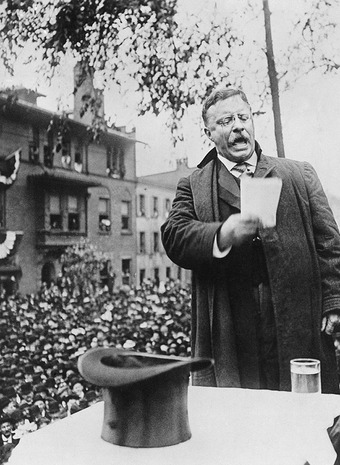
Choose a Relevant Topic
Although Theodore Roosevelt was a great speaker, giving a speech about him today might not be relevant.
Another way to consider how to make the topic of a speech relevant is to consider the audience who will hear your speech. Ask yourself, “What topic would the audience find interesting or useful? ” If you feel committed to a particular topic, then begin thinking about how you can demonstrate why the topic is relevant to your audience. Doing this requires that you articulate why they should care about your chosen topic. But remember that an informative speech should try to communicate this in an unbiased way that does not rely heavily on emotional appeals.
13.2.5: Make Connections
Make connections among your ideas and with audience interests; use transitions, signposts, internal previews, and summaries when speaking.
Learning Objective
Explain how to make connections in your speech
Key Points
- Make connections among your ideas so you can connect the ideas into meaningful groups for your main points.
- Make connections between your interests and the audience interests to motivate attention during your speech.
- Make connections with transitions to show relationships and join ideas together.
- Make connections with signpost transitions to help the audience organize ideas by numbering the main points, such as first, second, etc.
- Make connections by using previews before main points and use internal summaries to connect one idea to what is coming next.
Key Terms
- connection
-
The point at which two or more things are connected; a feeling of understanding and ease of communication between two or more people.
- signpost
-
A particular type of transition in the form of a brief statement that indicates where the speaker is in the speech, such as “first” and “finally,” or that calls attention to a key idea, such as “now remember this.”
- transitions
-
Words or phrases that allow the reader to understand how adjacent parts of a communication are connected.
Make connections like the old time switchboard operator.
In order to make your informative speech effective, you can think of yourself as the old time switchboard operator and make connections!
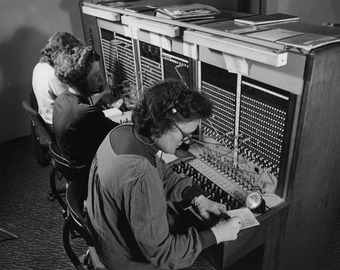
Connecting Information
In your speech, you should make connections between pieces of information for your audience.
Connect ideas and content when preparing the speech. After researching and collecting information for your speech, you will need to connect the ideas and different pieces of information into an organized message. You will group similar ideas together and connect them to form the main points of your speech. In addition to making connections between ideas and pieces of information, one of the most important connections is that between the speech and the audience.
Connect the topic to audience interests. There are many ways to establish this fundamental connection. One of the ways is to explain why the topic of the speech is important. This might occur in the introduction of the speech where you lay out what your speech will say. In addition to laying out the trajectory of the speech, you would include an additional explanation of why the topic is relevant to the audience. Another way to make the connection between the speech and the audience is to express your own interest in the topic. Demonstrating your own excitement could help the audience connect with you and your ideas.
Connect the ideas in the speech with transitions. Transitions are certain words, expressions, or other devices that give text or speech greater cohesion by making it more explicit, or signaling how ideas are meant by the writer or speaker to relate to one another. Transitions can signal addition, example, contrast, comparison, concession, result, summary, time (often chronologically), and place. The following are examples of transitional words and phrases: last, first, second, next, but, on the other hand, moreover, in addition, furthermore, however, to begin with, otherwise, conclusively, lastly, secondly, thirdly, most importantly, in conclusion, to end with, first of all, last of all, to sum it up, last but not least, lastly, finally, for example, on top of all, ultimately, or nevertheless.
Connect the important ideas with signposts. Signposts are a particular type of transition in the form of a brief statement that indicates where the speaker is in the speech, such as first and finally. You use signpost transitions to help the audience organize ideas when you number the main points, such as first, second, etc. You will also use signposts transitions to help the audience remember ideas by telling them what is important by directing their attention to an idea or concept. For example, you might saynow get this, this is really important, or now remember this when you want to signpost the attention of the audience.
Connect ideas with internal previews and summaries. Often you will devote more time to connecting ideas than a simple word or phrase. You may provide a short introductory preview of what you are going to be talking about in order to prepare the audience for what will come next. Additionally, you may want to summarize what you have just said to connect one main point to the next before you start talking about your next point.
13.2.6: Tailor Abstraction to Your Audience
Tailor abstraction to the specific content and the audience level of understanding.
Learning Objective
Use concrete terminology and abstract terminology when it is appropriate for your audience
Key Points
- The ability to simplify experiences with a word makes it easier to communicate, but it also makes us lose the connection to the specific meaning that we want to convey through the abstract wording.
- When you want the audience to make a concrete connection to their direct experience, remember to come down to earth on the the abstraction ladder. You can move up the ladder again to talk about boarder concepts.
- Your objective when choosing words is not to avoid abstract general words altogether, but rather to avoid using them when your audience needs more specific,concrete connections to what you are saying.
Key Term
- abstraction
-
The act of comparing commonality between distinct objects and organizing using those similarities.
Abstraction and the Abstraction Ladder
Abstraction is the process of perceiving similarities from our direct, specific observations in the universe, organizing the similarities, and then assigning a word label for the more general concept. The ability to simplify experiences with a word makes it easier to communicate, but it also makes us lose the connection to the specific meaning that we want to convey through the abstract wording.
Abstraction, the Process
I see a number of different objects and I see something similar about all of them, let’s say the color. I take this one characteristic, the color, and give it a label, for example, red. Here I have a direct observable experience with the objects and I see the color in them. I abstract the color and give it the label red. For you my label red is not connected with the objects I saw, but you may see similar objects and learn to assign the same label, red, to the color. We group together all the similar experiences to form a higher-level concept, which includes all the specific, individual observations we are engaging in abstraction.
Abstraction Ladder, the Concept
S. I. Hayakawa explained the concept using a ladder . Hayakawa used his cow Bessie to illustrate the four levels of abstraction from highest level four at the top to lowest at the bottom.

Ladder
Think of abstraction as a ladder. The most specific and direct experiences are at the bottom, while each step above is more abstract.
- 4 – Wealth
- 3 – Farm Asset
- 2 – Cattle
- 1 – Bessie, my cow
Lets look at another example with clothing. Level one is very specific, such as Levi 501. Moving up to level two, you have noun categories, such as clothing. Moving up a level, you have a broad noun class or group names such as manufactured goods or industry. Finally, at the top level, you have even more abstract concepts such as power, beauty, and casualness.
Almost anything can be described either in relatively abstract, general words or in relatively concrete, specific ones. You may say that you are writing on a piece of electronic equipment, or that you are writing on a laptop computer. You may say that your company produces consumer goods, or that it makes cell phones. When groups of words are ranked according to degree of abstraction, they form hierarchies.
Tailor the level of abstraction to the specific content and the audience level of
understanding
.
Using Concrete, Specific Words for Clarity
In general, as you move from one level to another while speaking, you will tailor the level of abstraction to the specific speech content and the audience level of understanding. You can increase the clarity, and therefore the usability, of your speaking by using concrete, specific words rather than abstract, general ones. Concrete words help your audience understand precisely what you mean. If you say that you want to produce television shows for a younger demographic segment, they won’t know whether you mean teenagers or toddlers. If you say that you study natural phenomena, your audience won’t know whether you mean volcanic eruptions or the migrations of monarch butterflies. Such vagueness can hinder audience from getting the information they need in order to make decisions and take action. When you want the audience to make a concrete connection to their direct experience, remember to come down to earth on the the abstraction ladder. You can move up the ladder again to talk about boarder concepts.
For example, you will draw heavily on level one to create images of specific people, places, or things in the minds of your audience. You may move up and down the level of abstraction as needed. For example, if you are talking about a top-level abstraction such as transportation, you may need to make it real for the audience by describing actual means of transportation such as your green mountain bike for city use or your blue and silver BMW for longer trips.
Abstract and general terms do have important uses for different audiences and occasions. For example, in scientific, technical, and other specialized fields, speakers often need to make general points, describe the general features of a situation, or provide general guidance for action.
Use abstract and specialized terminology to communicate
messages
economically.
Specialized, abstract terminology only works when your audience will understand them. You can use the specialized terminology of a particular profession or group if you know that they already have specific connections to the more abstract terminology. With audiences who understand the abstractions, the technical meanings can communicate messages economically with fewer words than if you started with specific instances at the bottom of the abstraction ladder.
Your objective when choosing words is not to avoid abstract general words altogether, but rather to avoid using them when your audience needs more specific, concrete connections to what you are saying.
13.2.7: Make It Memorable
Making your speech memorable is a way to improve its ability to inform the audience.
Learning Objective
List ways to make your speech memorable for your audience
Key Points
- Use visual aids to help make your speech memorable.
- Repeat key points of your speech to make it more memorable.
- Making your speech memorable is important because it increases the likelihood that the audience will walk away informed.
Key Term
- memorable
-
Worthy to be remembered; very important or remarkable.
Remember that the goal of an informative speech is to inform the audience . Ideally, not only are they informed while you are speaking, but they actually retain that information after you have left the podium. In order for this to happen, you have to make your speech memorable.
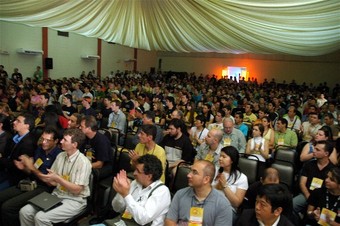
Memorable Speech
Making your informative speech memorable increases the likelihood that your audience will retain the information.
There are multiple ways to make your speech memorable. One way to do this is to repeat the key information that you want the audience to remember. This means repeating important information, within reason, throughout the speech. Lay out the important keys in the introduction of the speech, reiterate them in the body of the speech, and then repeat them again in the conclusion.
Another way to make your speech memorable is to use visual aids. Visual aids have the advantage of providing the information of your speech in an easily digestible form. In addition, visualizations have the ability to be uniquely captivating. Having an attractive visual can get the attention of the audience and improve the chances that they will remember the information contained in the visualization.
Though there are many ways to make an informative speech memorable, another way is to let yourself be engaged in the presentation of the speech. Demonstrating your own excitement by the speech’s topic has the possibility of drawing in the audience. If the speaker seems uninterested in the speech, then why should the audience be engaged? Therefore, let yourself be absorbed and excited by the speech, which might lure in the audience and make the speech more memorable.
These are just a few ways to make your speech memorable. Remember, the goal of making an informative speech memorable is to increase the likelihood that your audience will walk away informed. Using visual aids and repetition of key points are two strategies to use in order to deliver an effective informative speech.
13.2.8: Utilizing Devices to Enhance Audience Understanding
Visual aids, microphones, video screens, and/or a podium can help enhance audience understanding.
Learning Objective
Describe the use of devices in public speaking
Key Points
- Visual aids such as graphs, handouts, slide show presentations, and objects can help audiences understand complicated subjects. Many people learn visually and need information provided in this context, as well as orally, to enhance learning.
- A podium can help the presenter provide the audience with necessary information on a topic by offering a place for the speaker to have cue cards or scripts.
- A microphone is a good way to make sure that everyone in the audience hears the presentation properly. Wireless headsets allow the speaker to amplify the presentation while moving about the audience or reviewing visual aids.
- A video screen is a good way to make sure the audience can see the entire presentation in a large venue.
Key Term
- podium
-
A platform on which to stand, as when conducting an orchestra, preaching at a pulpit, or delivering a speech.
Utilize Devices to Enhance Audience Understanding
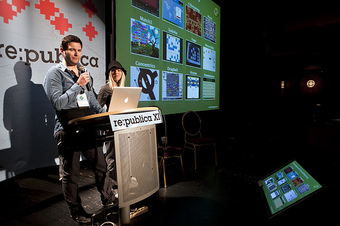
Visual Aid
Using a visual aid, like a large-screen digital projector, helps inform the audience.
Visual Aids
Many people need the assistance of visual material to understand complicated topics. Visual aids help the speaker reinforce the information provided in the speech to increase absorption and retention of the material. Visual aids can include objects, models, handouts, graphs, charts, photos, and slide show presentations. With visual aids, a speaker needs to make sure they adequately enhance the presentation without causing a distraction for the audience.
Podium/Rostrum
A podium can help an audience understand a speech. It allows the speaker to have notes or scripts to make sure the important information is covered regarding the subject matter. Additional information can be included in the notes so that if the audience has any questions the speaker can make sure they provide a complete answer.
Amplification
Amplification is important to make sure that the entire audience can hear the speech properly. Some large auditoriums and amphitheaters are designed to assist acoustics. Still, a microphone is a beneficial addition to a speaker’s toolkit. With the advancements in wireless technology, a headset can also be used, enabling the speaker to move about during the presentation, go over visual aids, or enter the audience during the question and answer session.
Video Screens
Video screens are beneficial for an audience, especially those who are seated in a large venue. The screens can help the audience see the speaker and the visual aids better, especially if they are in the back of the room or off to the far right or far left of the stage. Video screens are often available at modern conference centers and auditoriums that can be synced with presentation devices.
With the addition of visual aids, podiums, microphones, and video screens, a presenter can ensure that the audience is able to see, hear, and understand the material properly. When determining the type of visual aids needed for a speech, the speaker needs to consider the subject matter, audience, and venue so that the right materials are used to enhance audience understanding.
13.3: Sample Informative Speech
13.3.1: Sample Informative Speech
On May 1, 2011, President Barack Obama delivered an informative speech to the international community on the death of Osama bin Laden.
Learning Objective
Identify ways in which President Obama’s speech about the death of Osama bin Laden was a good example of an informative speech
Key Points
- In the late hours of May 1, 2011, President Barack Obama gathered in the East Room of the White House to address America and the world that Al Qaeda’s highest commander, Osama bin Laden, had been killed via military actions in Pakistan.
- President Obama gives context by describing the events of September 11, 2001 and bin Laden’s instrumental role in that day’s events.
- The President shares some details on international intelligence gathering on bin Laden’s current location as well as the decision-making process to proceed with the military operation on the bin Laden compound in Abbottabad, Pakistan.
- The President’s speech is largely focused on events and processes, two examples of informative speeches. He describes the events of September 11, 2001 and the military operation on May 1, 2011 as well as the process of how that military operation was carried out.
- The President concludes his speech by thanking the many people involved in the locating and killing of Osama bin Laden, as well as the patience and resolve of the American people in the years since September 11, 2001.
Key Terms
- excerpt
-
A clip, snippet, passage or extract from a larger work such as a news article, a film, a literary composition, or other media.
- intelligence
-
A political or military department, agency or unit designed to gather information, usually secret, about the enemy or about hostile activities.
- firefight
-
A skirmish involving an exchange of gunfire.
Sample Informative Speech
The following excerpts are taken from President Barack Obama’s informative remarks to the American people of the death of Osama bin Laden, given on May 1, 2011.
Good evening. Tonight, I can report to the American people and to the world that the United States has conducted an operation that killed Osama bin Laden, the leader of al Qaeda, and a terrorist who’s responsible for the murder of thousands of innocent men, women, and children.
It was nearly 10 years ago that a bright September day was darkened by the worst attack on the American people in our history. The images of 9/11 are seared into our national
memory
— hijacked planes cutting through a cloudless September sky; the Twin Towers collapsing to the ground; black smoke billowing up from the Pentagon; the wreckage of Flight 93 in Shanksville, Pennsylvania, where the actions of heroic citizens saved even more heartbreak and destruction…
…We were also united in our resolve to protect our nation and to bring those who committed this vicious attack to justice. We quickly learned that the 9/11 attacks were carried out by al Qaeda — an organization headed by Osama bin Laden, which had openly declared war on the United States and was committed to killing innocents in our country and around the globe. And so we went to war against al Qaeda to protect our citizens, our friends, and our allies.
Over the last 10 years, thanks to the tireless and heroic work of our military and our counterterrorism professionals, we’ve made great strides in that effort. We’ve disrupted terrorist attacks and strengthened our homeland defense. In Afghanistan, we removed the Taliban government, which had given bin Laden and al Qaeda safe haven and support. And around the globe, we worked with our friends and allies to capture or kill scores of al Qaeda terrorists, including several who were a part of the 9/11 plot.
Yet Osama bin Laden avoided capture and escaped across the Afghan border into Pakistan. Meanwhile, al Qaeda continued to operate from along that border and operate through its affiliates across the world.
And so shortly after taking office, I directed Leon Panetta, the director of the CIA, to make the killing or capture of bin Laden the top priority of our war against al Qaeda, even as we continued our broader efforts to disrupt, dismantle, and defeat his network.
Then, last August, after years of painstaking work by our intelligence community, I was briefed on a possible lead to bin Laden. It was far from certain, and it took many months to run this thread to ground. I met repeatedly with my national security team as we developed more
information
about the possibility that we had located bin Laden hiding within a compound deep inside of Pakistan. And finally, last week, I determined that we had enough intelligence to take action, and authorized an operation to get Osama bin Laden and bring him to justice.
Today, at my direction, the United States launched a targeted operation against that compound in Abbottabad, Pakistan. A small team of Americans carried out the operation with extraordinary courage and capability. No Americans were harmed. They took care to avoid civilian casualties. After a
firefight
, they killed Osama bin Laden and took custody of his body.
For over two decades, bin Laden has been al Qaeda’s leader and symbol, and has continued to plot attacks against our country and our friends and allies. The death of bin Laden marks the most significant achievement to date in our nation’s effort to defeat al Qaeda…
…Tonight, I called President Zardari, and my team has also spoken with their Pakistani counterparts. They agree that this is a good and historic day for both of our nations. And going forward, it is essential that Pakistan continue to join us in the fight against al Qaeda and its affiliates…
…We give thanks for the men who carried out this operation, for they exemplify the professionalism, patriotism, and unparalleled courage of those who serve our country. And they are part of a
generation
that has borne the heaviest share of the burden since that September day.
Finally, let me say to the families who lost loved ones on 9/11 that we have never forgotten your loss, nor wavered in our commitment to see that we do whatever it takes to prevent another attack on our shores.
And tonight, let us think back to the sense of unity that prevailed on 9/11. I know that it has, at times, frayed. Yet today’s achievement is a testament to the greatness of our country and the determination of the American people…
…Thank you. May God bless you. And may God bless the United States of America.
